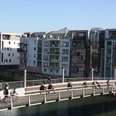Korbach developed at the end of the 8th century from a Carolingian imperial court, first mentioned in 980. The city was strategically located at the important intersection of trade routes from Frankfurt to Bremen and from Cologne to Leipzig, quickly becoming a significant market town. In 1188, it was granted the Soest city rights, similar to Lübeck.
After the unification of the old and new towns in 1377, Korbach's prosperity continued to grow. Encouraged by its favorable position along the trade routes, Korbach merchants engaged more extensively in long-distance trade: they can be traced back to the 15th century in Deventer (Flanders) and Reval (Estonia), and since then, Korbach has been the only city in Hesse to be a member of the Hanseatic League.
To this day, you can experience numerous testimonies from Korbach's significant past. Parts of the outer masonry and the Gothic staircase gable with the relief of the city coat of arms have survived from the old town hall built in 1377, despite the great city fire of 1664. Additionally, the two Gothic churches, the city fortifications with the almost completely preserved double city wall, and several stone chambers used as storehouses at that time, all serve as reminders of Korbach's Hanseatic era.
The "Goldspur Korbach" from the main railway station through the old town and the interactive historical city tour "Zwischen den Mauern" (Between the Walls) bring the past to life. The multiple award-winning Wolfgang-Bonhage-MUSEUM KORBACH is partially housed in one of the stone chambers from the Hanseatic period. And the pedestrian zone in the midst of the historic old town, with its attractive boutiques, department stores, and street cafes, offers a delightful shopping experience.
Good to know
Payment methods
Social Media
Documents
Author
Korbach-Information
Organization
License (master data)
Nearby







